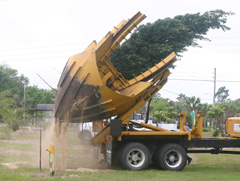Home > Planting trees > Plant details > Time of year and transplanting
Time of year and transplanting
 Trees in containers in warm climates where soil does not freeze for extended
periods (hardiness zones 7 through 11) are routinely planted year-round. Soil
temperatures are usually warm enough for some root growth in winter, especially
in zones 8 through 11. Trees planted in the fall can establish roots into the
landscape soil before warm summer temperatures draw moisture from and stress
the trees. This could give them an edge over trees planted the following spring
which will have few roots out into the landscape soil when warm temperatures
arrive soon after planting.
Trees in containers in warm climates where soil does not freeze for extended
periods (hardiness zones 7 through 11) are routinely planted year-round. Soil
temperatures are usually warm enough for some root growth in winter, especially
in zones 8 through 11. Trees planted in the fall can establish roots into the
landscape soil before warm summer temperatures draw moisture from and stress
the trees. This could give them an edge over trees planted the following spring
which will have few roots out into the landscape soil when warm temperatures
arrive soon after planting.
Despite this reasoning, one study reports slightly better growth from planting Southern Magnolia in spring than fall (Hensley et al. 1988). Containers are a fairly new commodity in the cooler climates so there is less research and experience to rely on there. They are likely to transplant fine during the seven to nine warmest months of the year.
Many of the coarse-rooted trees, such as oaks, grown in field nurseries are dug in the dormant season because survival is better compared to other times. Many finer-rooted trees, such as holly and elm, are dug in the dormant period or during the growing season. These trees are sold during the following months.
Field-grown trees dug several weeks or months prior to shipping to the landscape site are said to be "hardened off". Freshly dug trees are not "hardened off" and are very susceptible to death if not watered appropriately (Gilman 2001). During the "hardening off" period, roots of B&B trees begin to regenerate within the root ball. Roots often grow through the burlap wrapped around the root ball of a hardened off tree. Some nurseries in the warmer climates provide overhead irrigation to the foliage of evergreens during the hardening off period, especially with summer digging.
Purchasing freshly dug trees that are not hardened-off is not recommended because their chances for survival are dim. Hardened-off B&B trees can be planted any time.
Many nurseries and landscape contractors prefer not to dig field grown trees while shoots are actively elongating because young, succulent shoot tissue is sensitive to drying out. Roots on many species grow slowly at this time so they wait until leaves have fully expanded and turn dark green.
However, nurseries continue to report to me that when pushed for time, they dig certain species during active shoot elongation with great success. Survival during this time of year appears to be greater for trees previously root pruned (Gilman et al. 2002). I have transplanted 10 inch caliper live oak as new shoots were emerging in April with a 90-inch tree spade; all tree survived, probably due to the daily irrigation they received following transplanting.
Rely on local wholesale nursery operators for guidance. They probably are the ones that most understand the optimum digging times for your area because they do it year-in and year-out.
In cooler climates, a number of B&B and bare root trees recover best from transplanting in late winter or spring when roots on some trees begin active growth. Many nursery operators have trouble transplanting bare root and B & B trees, including oaks and filberts, in the fall perhaps due to slow root regeneration until bud swell in the spring (Harris and Bassuk 1994).
Good and Corell (1982) found that fall planting can be successful if conducted at least 4 weeks before soil temperatures drop below 40 degrees. This probably allowed for some root regeneration before winter. According to Harris et al. 2002, after conducting many experiments on a variety of deciduous temperate trees, transplanting in early fall confers earlier post-transplant root growth on field-grown trees and therefore is the best time of year to transplant most cold-hardy deciduous landscape trees.
In zone 9, roots on Live Oak regenerate best during the months of July and August when shoots are not elongating (Beeson 1995). A large summer flush of root growth is common on a great number of other tree species. Some nurseries now dig Live Oak, magnolias, hollies, elms and certain other species in summer to take advantage of this. This also spreads out the digging times and provide more flexibility to the nursery operators.

